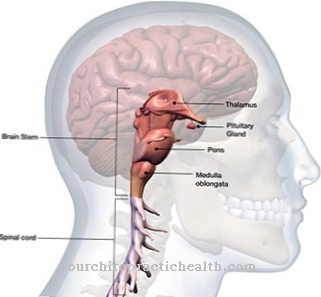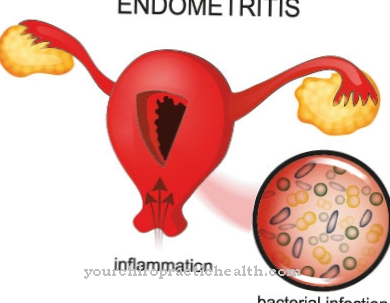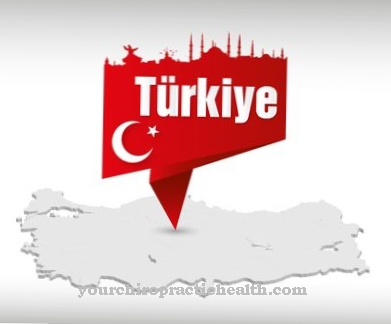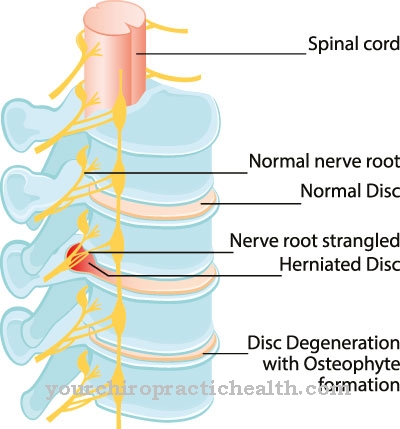Scheuermann's disease is a disease of the spine that often manifests itself in growing age. When the vertebral body is not growing, wedge-shaped vertebrae form, which narrow the intervertebral discs. This creates the rounded back with a hollow back that is typical of Scheuermann's disease.
What is Scheuermann's disease?
.jpg)
© La Gorda - stock.adobe.com
The Scheuermann's disease was discovered by the Danish radiologist Holger Scheuermann and named after him. It affects more male than female adolescents. It is estimated that around 10-20% of the population is affected by this growth disorder of the vertebral bodies to a greater or lesser extent.
Malformations of the base and cover plates of adjacent vertebral bodies occur, mainly in the thoracic vertebral area, which lead to a wedge-shaped formation of the vertebral bodies. As a result, the intervertebral discs between the vertebral bodies are narrowed, which leads to various complaints in later years of life.
If the thoracic vertebrae are affected by the growth disturbance, the typical hunchback with a hollow back and curvature of the spine is formed. If, on the other hand, the vertebral bodies of the lumbar spine are affected, a flat back develops. Scheuermann's disease is also called Osteochondritis deformans juvenilis dorsi designated.
causes
The actual causes for the development of this growth disorder are still unknown. However, one suspects both a genetic predisposition and external influences that favor the growth disorders. In addition to genetic predisposition, metabolic disorders and hormonal influences also seem to play a role in puberty.
Various external factors, such as poor posture when sitting at a desk for hours in a bent position or weak muscles due to insufficient physical activity, are also considered to be beneficial for Scheuermann's disease. The bent posture creates increased pressure on the front edges of the thoracic spine. Since the growth zone of the vertebral bodies is located in the edge areas, the growth of the vertebral bodies is impaired and slowed down by the increased pressure on the leading edge.
As a result, the vertebral bodies grow more strongly at the rear edge than at the front edge, as a result of which wedge-shaped vertebral bodies are formed. This in turn leads to a reduction in the distance between the vertebral bodies, to a flattening of the intervertebral discs and to a greater risk of breakage of the base and cover plates of the vertebral bodies. Another cause of Scheuermann's disease is mechanical overuse of the spine, for example in competitive athletes.
Symptoms, ailments & signs
Scheuermann's disease can often already be recognized externally by a clear rounding of the thoracic spine and a possibly compensating hollow back in the lumbar spine area. The symptoms and complaints associated with Scheuermann's disease can be derived directly from the external appearance.
The strong curvature forwards in the chest area results in back pain and neck tension, especially in an advanced state. Headaches are also possible. Further tension in muscles is caused by the fact that the spine in the affected area clearly loses mobility. In the thoracic spine area, this can also lead to pain in the shoulders and arms.
The internal organs also not infrequently react to the non-physiologically constricted conditions. For example, if Scheuermann's disease is severe, the lungs cannot freely develop for deep inhalation. Cardiac arrhythmias and stomach problems are also among the late symptoms of Scheuermann's disease.
The lumbar spine often reacts to the curvature of the thoracic spine in a balanced way by creating a pronounced hollow back and hypermobility. This can also lead to problems. A typical symptom is pain in the lower back, which occurs especially when the abdominal muscles are weak.
Further complications are pain in the legs with a clearly radiating character, which can be the result of an incursion of disc material into the spinal canal caused by the increased formation of the hollow back.
Diagnosis & course
_2.jpg)
The diagnosis Scheuermann's disease is created by an X-ray diagnosis.The x-ray shows the typical curvature of the spine and the wedge-shaped deformed vertebral bodies.
At the beginning of the disease there are hardly any symptoms. In the further course, the shoulders are pulled forward and the back is rounded. The hunched back places increased stress on the lumbar spine and creates a hollow back. In order to reduce the pain, those affected often adopt a bad posture, which leads to signs of wear and tear on the vertebral bodies and impairment of the muscles, tendons and ligaments.
In most cases of Scheuermann's disease, however, the clinical picture does not fully develop, since the incorrect growth also ends at the end of the growth phase.
Complications
Scheuermann's disease primarily leads to a curvature of the patient's spine. In most cases, this is associated with relatively severe pain, so that those affected suffer from movement restrictions. The pain can also occur at night and lead to sleep problems or other unpleasant feelings and depression. It is not uncommon for the pain in the back to spread to other regions of the body.
The back pain itself significantly restricts the patient's everyday life and leads to a significantly reduced resilience of the patient. Furthermore, the growth of children is noticeably restricted and delayed by Scheuermann's disease. This can lead to consequential damage in adulthood, which in most cases is irreversible.
Scheuermann's disease is treated with the help of various therapies. This allows the pain to be limited and treated relatively well. There are no particular complications. As a rule, surgical interventions are only carried out if the case is serious. The life expectancy of those affected is usually not reduced by Scheuermann's disease.
When should you go to the doctor?
Special features of the skeletal system must always be examined by a doctor. If there are abnormalities in the growth process in children or adolescents, a doctor should be consulted as soon as possible. There is a special duty of care if the spine changes its appearance. If a bad posture of the body can be noticed, a doctor's visit is necessary.
Back pain or neck discomfort should be presented to a doctor. Taking pain medication is generally only recommended after consulting a doctor, as the risk of side effects or complications is very high. Headaches, musculoskeletal disorders, heart rhythm disorders and breathing problems must be examined and treated.
If the person is unable to take a deep breath, there is cause for concern. A severe arching of the back, restricted mobility or a decrease in the usual physical resilience should be discussed with a doctor. If the everyday school or professional obligations cannot be fulfilled or if participation in sporting activities is restricted, a doctor is required. If you experience emotional or mental problems due to the visual flaw or reduced mobility, you should consult a doctor. In the case of depressive moods, aggressive behavior or withdrawal from social life, it is advisable to consult a doctor.
Treatment & Therapy
In mild cases of the Scheuermann's disease targeted physiotherapy is sufficient. With the physiotherapy exercises a healthy posture is trained and the back muscles are strengthened. It is important to exercise regularly, which counteracts the curvature of the spine.
Special back exercises, swimming and hiking serve to strengthen the muscles and maintain a healthy posture. It is also helpful to wear a corset during the growth phase, which forces the upper body to adopt a healthy posture and promotes healthy growth of the vertebral bodies.
An operation may only be necessary in particularly severe cases, when pronounced poor posture and the associated severe back pain have occurred. The defective intervertebral discs are removed and replaced with pieces of bone previously removed from the ribs or the iliac crest. However, this surgical method is only successful in about half of all cases and involves certain risks.
You can find your medication here
➔ Medicines for back painOutlook & forecast
In general, the prognosis for Scheuermann's disease is favorable if therapy is started early. The deformation of the spine usually only occurs during puberty and, if left untreated, can lead to more or less severe deformations of the spine (hump, scoliosis, hyperkyphosis).
It is therefore important to make a diagnosis in good time and to have regular follow-up checks, during which the so-called "Cobb angle" (measure of the curvature of the vertebrae) is determined. From this, the measures are derived that slow down the progression of the spinal column deformation or, ideally, even stop it.
The targeted training of the back muscles through appropriate physiotherapy has a positive effect on the prognosis. Sports that strengthen your back muscles (such as swimming) can also have positive effects on symptoms and spinal development. Very good results are achieved with the use of a supporting corset. Diet should also not be neglected. Deficiency symptoms favor Scheuermann's disease.
With the end of growth, Scheuermann's disease does not progress any further. However, secondary damage (herniated disc, postural damage, neurological abnormalities) can still occur. Important factors are, above all, too little exercise, an unfavorable posture (sitting much stooped) and being overweight. These generally have a negative effect on the prognosis of Scheuermann's disease.
prevention
To prevent the Scheuermann's disease This includes avoiding poor posture in children and adolescents, for example by setting the height of the desk to suit their height and an ergonomically shaped chair. Regular exercise strengthens the back and abdominal muscles, supports the spine and promotes a healthy posture. Endurance sports such as swimming and running are beneficial, while competitive sports as well as lifting and carrying heavy loads and the associated heavy mechanical stress on the spine should be avoided.
Aftercare
Just like the therapy, the follow-up treatment for Scheuermann's disease depends on the extent of the pain, the extent of the hunched back and the age of the patient. Orthopedists and physiotherapists usually work together for aftercare. The patient's input also plays an important role. For example, he should do the physiotherapy exercises he is learning at home on a regular basis to help his recovery.
The physiotherapy exercises shorten the chest muscles and prevent an unhealthy crooked posture. The muscles in the upper part of the back are strengthened. This in turn has a positive effect on straightening the spine. Precise execution to strengthen muscles is possible in rehabilitation as well as in fitness studios. The risk of injury can also be reduced in this way.
In addition to performing physiotherapy measures, sports advice is helpful both for the children concerned and for their parents. So it is important to know which sports have a positive effect and which do not. Water sports such as backstroke swimming are considered cheap. On the other hand, artistic gymnastics, cycling, trampoline jumping or rowing are classified as negative.
The aim of aftercare is to stabilize the alignment of the spine in order to counteract progressive deformation. Obesity can negatively affect treatment. In most cases, however, there are no severe forms of Scheuermann's disease to be feared.
You can do that yourself
The typical symptoms of Scheuermann's disease are closely related to posture. In many cases this means: the more curled up the patient sits or stands, the more pain is reported. This is where self-help around Scheuermann's disease comes in: the more upright the posture, the greater the sense of well-being and, often, the better the therapeutic success of conventional medicine and physiotherapy. The patient can therefore help himself if he follows the prescribed physiotherapy with all its sessions consistently and also conscientiously carries out exercises recommended for at home. Even a corset, which can be prescribed in more severe cases, must be worn with great self-discipline.
In everyday life, the patient can also do a lot to alleviate or even eliminate the symptoms caused by Mobus Scheuermann. This includes in particular strengthening the core muscles (stomach and especially back), which are responsible for straightening the body and thus the spine. This should always be done in consultation with the attending physician or physiotherapist. Strengthening exercises on the machines in the gym that are specially designed for these muscle groups are particularly suitable. Swimming or walking train not only the back muscles but also endurance. When lying down while sleeping or reading, it is often helpful to take the prone position from time to time.



.jpg)




















.jpg)



